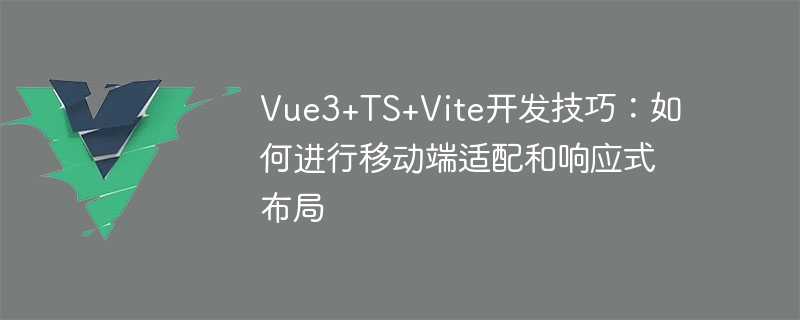Home >Web Front-end >Vue.js >Vue3+TS+Vite development skills: how to carry out mobile adaptation and responsive layout
Vue3+TS+Vite development skills: how to carry out mobile adaptation and responsive layout
- WBOYWBOYWBOYWBOYWBOYWBOYWBOYWBOYWBOYWBOYWBOYWBOYWBOriginal
- 2023-09-11 08:25:472157browse

The development of mobile Internet has further promoted the popularity of mobile devices. As front-end developers, we need to take into account different sizes of device screens and different resolutions when developing mobile applications. rate adaptation problem. This article will introduce how to use Vue3, TypeScript and Vite for mobile terminal adaptation and responsive layout development techniques.
Mobile terminal adaptation refers to adjusting the layout and style of page elements according to different mobile device screen sizes and resolutions to ensure that the page content is presented consistently on different devices. Responsive layout means that the layout of the page can automatically adapt to changes in different screen sizes.
First of all, we use Vite as a project development tool. It is a new generation of front-end construction tools that has out-of-box features and can quickly build a project environment.
After the project initialization is completed, we start to introduce Vue3 and TypeScript. Vue3 is a progressive JavaScript framework for building user interfaces. It provides a more powerful and flexible development method through the Composition API; while TypeScript is a static type-checked JavaScript superset that can improve the maintainability and reliability of the code. Readability.
Next, we need to adapt to the mobile terminal. In Vue3, this can be achieved using CSS units and media queries. First, we use vw (a percentage of the viewport width) as the CSS unit to automatically resize elements based on the device screen width. For example, we can set the width of the element to 100vw, which means that its width will occupy the entire width of the screen.
In addition to using vw units, we can also use media queries to set different styles according to different screen widths. With @media rules, different styles can be defined for different screen widths. For example, we can set the element's font size to 14px on screens smaller than 600px wide, and 16px on screens larger than 600px wide.
When adapting to mobile terminals, we also need to pay attention to the setting of font size. Due to different screen sizes and resolutions of mobile devices, font sizes may appear differently. In order to ensure the readability and consistency of the font on different devices, you can use rem units to set the font size. The rem unit is relative to the font size of the root element (html). We can set a base font size on the root element and then set it in other elements using rem units. This way, the font size will automatically scale based on the font size of the root element on different devices.
In addition to the adaptation of mobile devices, we also need to consider the issue of screen rotation during mobile development. When the user rotates the device screen, the page needs to be laid out accordingly. In Vue3, you can monitor window size changes through the watch function, and then modify the page layout and style according to the window size.
In addition to mobile adaptation, we also need responsive layout. In Vue3, you can use Flex layout and Grid layout to implement responsive layout. Flex layout is a flexible box layout that can easily realize automatic filling and adaptive adjustment of elements; Grid layout is a two-dimensional grid layout that can divide the page into several grids to facilitate the arrangement and positioning of elements. .
When using Flex layout and Grid layout, we can use @media rules and media queries to define the layout method under different screen sizes. By setting different grid areas and flexible box properties, the page can be automatically adjusted under different screen sizes.
To sum up, the development skills of using Vue3, TypeScript and Vite for mobile terminal adaptation and responsive layout can greatly improve our efficiency and user experience in mobile terminal development. By rationally using CSS units, media queries and Flex layout/Grid layout, we can easily adapt to mobile devices of different sizes and realize automatic adjustment and optimization of the page. I hope this article will be helpful to you in your mobile development!
The above is the detailed content of Vue3+TS+Vite development skills: how to carry out mobile adaptation and responsive layout. For more information, please follow other related articles on the PHP Chinese website!

